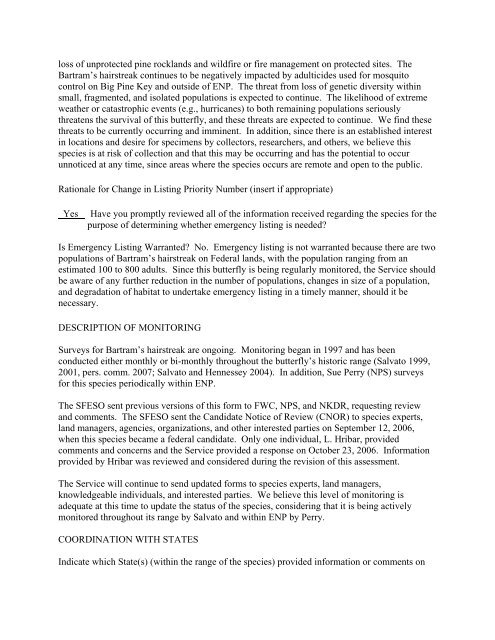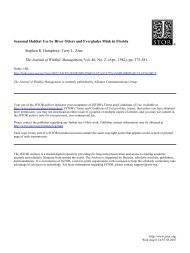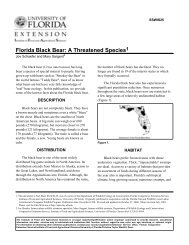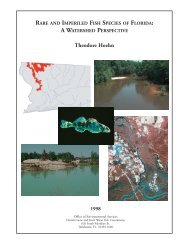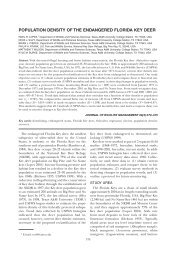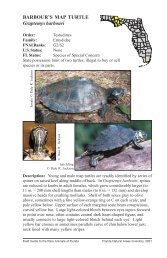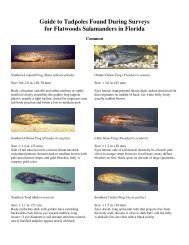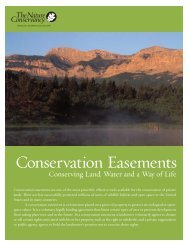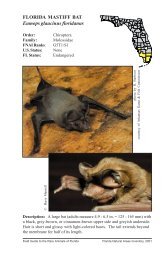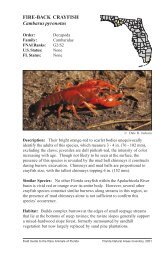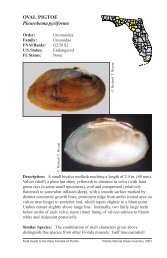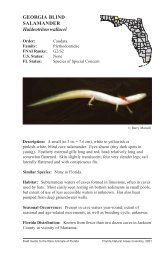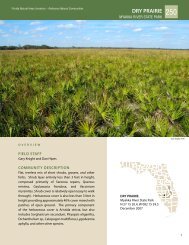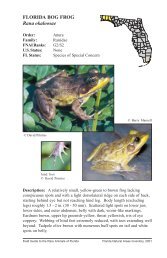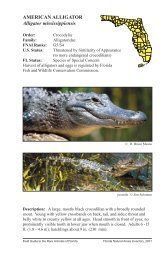Bartram's hairstreak butterfly - Florida Wildlife Conservation Guide
Bartram's hairstreak butterfly - Florida Wildlife Conservation Guide
Bartram's hairstreak butterfly - Florida Wildlife Conservation Guide
Create successful ePaper yourself
Turn your PDF publications into a flip-book with our unique Google optimized e-Paper software.
loss of unprotected pine rocklands and wildfire or fire management on protected sites. The<br />
Bartram’s <strong>hairstreak</strong> continues to be negatively impacted by adulticides used for mosquito<br />
control on Big Pine Key and outside of ENP. The threat from loss of genetic diversity within<br />
small, fragmented, and isolated populations is expected to continue. The likelihood of extreme<br />
weather or catastrophic events (e.g., hurricanes) to both remaining populations seriously<br />
threatens the survival of this <strong>butterfly</strong>, and these threats are expected to continue. We find these<br />
threats to be currently occurring and imminent. In addition, since there is an established interest<br />
in locations and desire for specimens by collectors, researchers, and others, we believe this<br />
species is at risk of collection and that this may be occurring and has the potential to occur<br />
unnoticed at any time, since areas where the species occurs are remote and open to the public.<br />
Rationale for Change in Listing Priority Number (insert if appropriate)<br />
Yes<br />
Have you promptly reviewed all of the information received regarding the species for the<br />
purpose of determining whether emergency listing is needed<br />
Is Emergency Listing Warranted No. Emergency listing is not warranted because there are two<br />
populations of Bartram’s <strong>hairstreak</strong> on Federal lands, with the population ranging from an<br />
estimated 100 to 800 adults. Since this <strong>butterfly</strong> is being regularly monitored, the Service should<br />
be aware of any further reduction in the number of populations, changes in size of a population,<br />
and degradation of habitat to undertake emergency listing in a timely manner, should it be<br />
necessary.<br />
DESCRIPTION OF MONITORING<br />
Surveys for Bartram’s <strong>hairstreak</strong> are ongoing. Monitoring began in 1997 and has been<br />
conducted either monthly or bi-monthly throughout the <strong>butterfly</strong>’s historic range (Salvato 1999,<br />
2001, pers. comm. 2007; Salvato and Hennessey 2004). In addition, Sue Perry (NPS) surveys<br />
for this species periodically within ENP.<br />
The SFESO sent previous versions of this form to FWC, NPS, and NKDR, requesting review<br />
and comments. The SFESO sent the Candidate Notice of Review (CNOR) to species experts,<br />
land managers, agencies, organizations, and other interested parties on September 12, 2006,<br />
when this species became a federal candidate. Only one individual, L. Hribar, provided<br />
comments and concerns and the Service provided a response on October 23, 2006. Information<br />
provided by Hribar was reviewed and considered during the revision of this assessment.<br />
The Service will continue to send updated forms to species experts, land managers,<br />
knowledgeable individuals, and interested parties. We believe this level of monitoring is<br />
adequate at this time to update the status of the species, considering that it is being actively<br />
monitored throughout its range by Salvato and within ENP by Perry.<br />
COORDINATION WITH STATES<br />
Indicate which State(s) (within the range of the species) provided information or comments on


